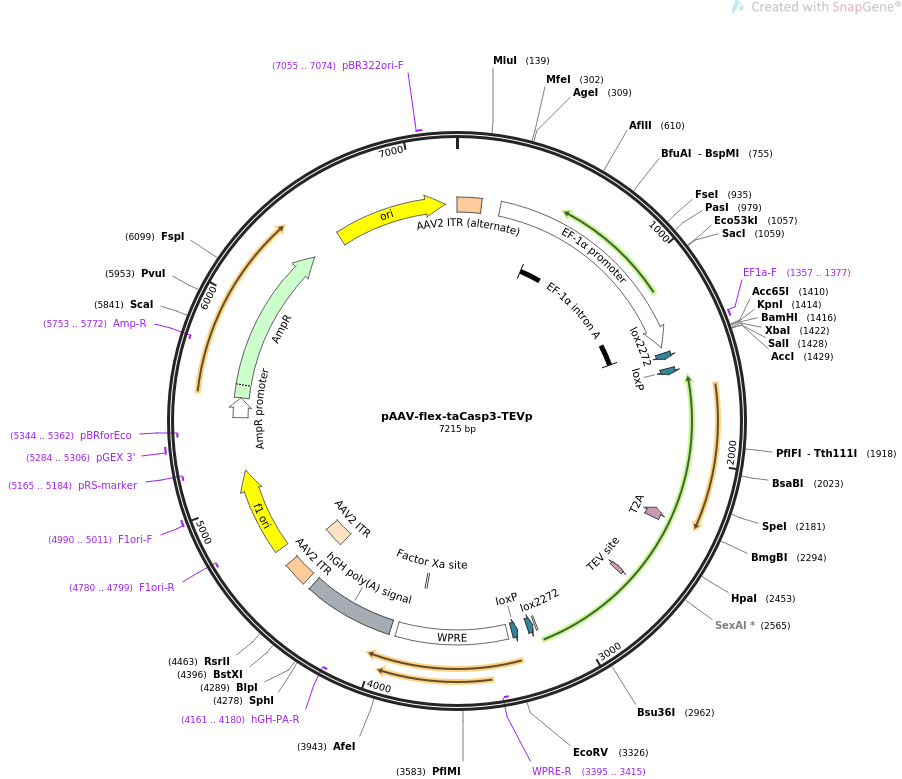-
Depositing Labs
-
Sequence Information
Ordering
| Item | Catalog # | Description | Quantity | Price (USD) | |
|---|---|---|---|---|---|
| Plasmid | 45580 | Standard format: Plasmid sent in bacteria as agar stab | 1 | $85 | |
| AAV5 | 45580-AAV5 | Virus (100 µL at titer ≥ 7×10¹² vg/mL) and Plasmid. | $405 | ||
Backbone
-
Vector backbonepAAV-MCS
-
Backbone manufacturerStratagene
- Backbone size w/o insert (bp) 5347
- Total vector size (bp) 7225
-
Vector typeAAV ; Adeno Associated Viral Vector
Growth in Bacteria
-
Bacterial Resistance(s)Ampicillin, 100 μg/mL
-
Growth Temperature30°C
-
Growth Strain(s)Stbl2
-
Growth instructionsFor liquid cultures grow in LB:2XYT (1:1) overnight at 30 C.
-
Copy numberLow Copy
Gene/Insert 1
-
Gene/Insert nameCaspase 3
-
Alt nameCasp3
-
SpeciesH. sapiens (human), Synthetic
-
Insert Size (bp)847
-
MutationLinker replaced with a TEV protease cleavage site
-
Entrez GeneCASP3 (a.k.a. CPP32, CPP32B, SCA-1)
- Promoter EF1a
Cloning Information for Gene/Insert 1
- Cloning method Unknown
- 5′ sequencing primer AAA GCA GCG TAT CCA C
- 3′ sequencing primer AAT CAT GTC CCT GCC GTC GAT C (Common Sequencing Primers)
Gene/Insert 2
-
Gene/Insert nameTobacco Etch Virus protease
-
Alt nameTEV protease
-
Insert Size (bp)705
- Promoter EF1a
Cloning Information for Gene/Insert 2
- Cloning method Unknown
- 5′ sequencing primer TTC TCA AGC CTC AGA CAG TGG
- 3′ sequencing primer AGA GGG GAT CGT TGT AGA AGT C (Common Sequencing Primers)
Resource Information
-
Articles Citing this Plasmid
Terms and Licenses
-
Academic/Nonprofit Terms
-
Industry Terms
- Not Available to Industry
Trademarks:
- Zeocin® is an InvivoGen trademark.
Depositor Comments
The taCasp3-T2A-TEVp transgene was generated by overlapping PCR of plasmids harboring taCasp3 and TEVp (Gray et al., 2010; Cell 142, 637-646 PMID: 20723762). This transgene was inserted in reverse orientation into the plasmid pAAV-EF1a-DIO-hChR2(H134R)-EYFP-WPRE-pA such that it replaced hChR2(H134R)-EYFP
Information for AAV5 (Catalog # 45580-AAV5) ( Back to top)
Purpose
Ready-to-use AAV5 particles produced from pAAV-flex-taCasp3-TEVp (#45580). In addition to the viral particles, you will also receive purified pAAV-flex-taCasp3-TEVp plasmid DNA.
EF1a-driven, Cre-dependent, bicicstronic expression of designer pro-taCasp3 and TEVp. These AAV preparations are suitable purity for injection into animals.Delivery
- Volume 100 µL
- Titer ≥ 7×10¹² vg/mL
- Pricing $375 USD for preparation of 100 µL virus + $30 USD for plasmid.
- Storage Store at -80℃. Thaw just before use and keep on ice.
- Shipment Viral particles are shipped frozen on dry ice. Plasmid DNA (≥ 200ng) will also be included in the shipment.
Viral Production & Use
- Packaging Plasmids encode adenoviral helper sequences and AAV rep gene, AAV5 cap gene
- Buffer PBS + 0.001% Poloxamer 188 + 200 mM NaCl
- Serotype AAV5
- Purification Iodixanol gradient ultracentrifugation
Biosafety
Requestor is responsible for compliance with their institution's biosafety regulations. Lentivirus is generally considered BSL-2. AAV is generally considered BSL-1, but may require BSL-2 handling depending on the insert. Biosafety Guide
Terms and Licenses
-
Academic/Nonprofit Terms
-
Industry Terms
- Not Available to Industry
Viral Quality Control
- Addgene ensures high quality viral vectors by optimizing and standardizing production protocols and performing rigorous quality control (QC) (see a list of our QC assays). The specific QC assays performed varies for each viral lot. To learn which specific QC assays were performed on your lot, please contact us.
- Titer: the exact titer of your sample will be reported on the tube. The titer you see listed on this page is the guaranteed minimum titer. See how titers are measured.
Visit our viral production page for more information.
Addgene Comments
Using FLEX vectors in vivo: LoxP sites in FLEX plasmids are known to recombine during DNA amplification and viral vector production, which may result in a minority of Cre-activated (i.e., "flipped") viral vectors. Addgene has measured this occurs in 0.1-0.8% of viral particles in our typical production protocol. This can lead to a small number of cells exhibiting Cre-independent transgene expression in vivo. To address this, it is necessary to optimize the injection volume and viral titer to find the optimal AAV dosage required for Cre-dependent transgene expression and function in vivo. This may include reducing the viral particle dosage in order to reduce the likelihood of Cre-independent expression.
These plasmids were created by your colleagues. Please acknowledge the Principal Investigator, cite the article in which the plasmids were described, and include Addgene in the Materials and Methods of your future publications.
-
For your Materials & Methods section:
pAAV-flex-taCasp3-TEVp was a gift from Nirao Shah & Jim Wells (Addgene plasmid # 45580 ; http://n2t.net/addgene:45580 ; RRID:Addgene_45580) For viral preps, please replace (Addgene plasmid # 45580) in the above sentence with: (Addgene viral prep # 45580-AAV5) -
For your References section:
Sexually dimorphic neurons in the ventromedial hypothalamus govern mating in both sexes and aggression in males. Yang CF, Chiang MC, Gray DC, Prabhakaran M, Alvarado M, Juntti SA, Unger EK, Wells JA, Shah NM. Cell. 2013 May 9;153(4):896-909. doi: 10.1016/j.cell.2013.04.017. 10.1016/j.cell.2013.04.017 PubMed 23663785





